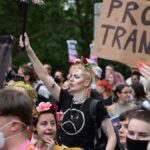Published October 22, 2003
The Catholic Difference
My favorite memory of Pope John Paul II? I must have been asked that question dozens of times in recent weeks, as the twenty-fifth anniversary of the Pope’s election approaches. The answer I invariably give often surprises my journalistic friends.
When I think back on the past quarter-century and ask myself what event or image or papal address best captures the meaning of John Paul II, I don’t find the answer in some of the more dramatic moments in the pontificate: his papal installation of October 22, 1978, with its clarion call, “Be not afraid! Open the doors to Christ!”; that epic first pilgrimage to Poland in June 1979, nine days in which the history of the twentieth century turned in a different and better direction; the showdowns with the Sandinistas in Nicaragua in 1983 and with Chilean rioters in 1987; the World Youth Days; the two great addresses to the United Nations; the opening of the Holy Door to begin the Great Jubilee of 2000. Rather, I think of something that took place out of the public eye.
It was Sunday, March 26, 2000, the last day of John Paul’s jubilee pilgrimage to the Holy Land. A week of televised drama on the Mount of Beatitudes and in Bethlehem, Nazareth, and Jerusalem was drawing to a close. That morning, the Pope had prayed at the Western Wall of Herod’s Temple, Judaism’s holiest site, and then celebrated Mass at the tomb of Christ in the Basilica of the Holy Sepulcher: two highly visible, very public expressions of his faith in the God of Abraham, Isaac, Jacob, and Jesus. It seemed to both the trip planners and the press that the only thing left for John Paul to do was to complete the formal farewell ceremonies at Ben-Gurion Airport and return to Rome.
The Pope had other ideas.
Quietly, during lunch, he asked whether he might be permitted to return to the Basilica of the Holy Sepulcher privately, to pray as a pilgrim. The authorities were aghast; how could security be arranged so quickly? But things were eventually worked out, and John Paul, who had a different sort of security in mind, returned to the Basilica. Then it became clear why he had wanted to return.
That morning, he hadn’t been able to pray at the eleventh and twelfth stations of the cross, which are on an upper floor of the great church. So now, a man just short of his eightieth birthday, who walked with difficulty and pain, climbed the steep, stone spiral steps up to Calvary. Having challenged the world to fearlessness – and having embodied fearlessness himself for more than two decades – he now wanted to pray at the place where the Son of God, taking all the world’s fear upon himself, had offered that fear, and himself, to the Father. That self-emptying, and the divine answer given to it in the resurrection, had enabled all of us to live without fear. That was why John Paul II was determined to pray at Calvary. He wanted to pray at the place where fear had been conquered through radical obedience and self-emptying love.
The entire pontificate comes into focus here, I think. John Paul II has been many things for the Church and the world these past twenty-five years: a brilliant teacher, a compelling leader, a shining personal example. He is all of those things, however, because he is first and foremost a Christian disciple. The exceptional talents and personal magnetism of Karol Wojtyla do not explain his accomplishments, nor do they get us to the core of his person. We have to look deeper for explanations and understanding.
We have to look to his faith. You cannot understand Karol Wojtyla, whom the world knows as Pope John Paul II, without confronting one, adamant fact: he truly believes, with every fiber of his being, that Jesus Christ is the answer to the question that is every human life. That is the conviction that makes him who and what he is. That is the conviction that drives his teaching, that makes possible his accomplishments, and that focuses his talents and his personality.
He is the great Christian witness of our time.
George Weigel is Distinguished Senior Fellow of the Ethics and Public Policy Center in Washington, D.C. and holds EPPC’s William E. Simon Chair in Catholic Studies.








